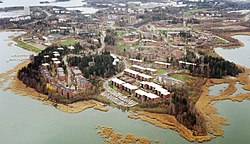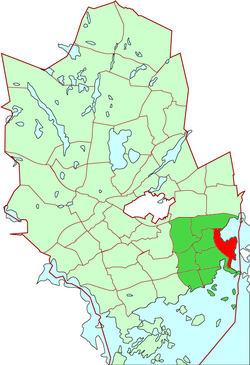Otaniemi
This article needs additional citations for verification. (November 2010) |
Otaniemi
Otnäs | |
|---|---|
 Otaniemi from the air (1989). | |
 Location of Otaniemi within Espoo | |
| Coordinates: 60°11′N 24°50′E / 60.183°N 24.833°E | |
| Country | Finland |
| Municipality | Espoo |
| Region | Uusimaa |
| Sub-region | Greater Helsinki |
| Main District | Suur-Tapiola |
| Inner District(s) | Otaniemi, Keilaniemi |
| Population (2006) | |
| • Total | 3,496 |
| Languages | |
| • Finnish | 82.6% |
| • Swedish | 4.3% |
| • Other | 13.2% |
| Jobs | 12,826 |
Otaniemi (Finnish), or Otnäs (Swedish), is a district of Espoo, Finland. It is located near the border of Helsinki, the capital of Finland.
Otaniemi is the home of Aalto University's campus, thus "Otaniemi" is often used as a synonym for Aalto. However, several research and business facilities are also located in Otaniemi. The most prominent institutions for science and engineering in Otaniemi are the VTT Technical Research Centre of Finland and the Geological Survey of Finland (GTK). Business is represented in the area by the business incubator Technopolis. In 2010, Otaniemi became home to Aalto University, formed from the merger of the Helsinki University of Technology, the University of Art and Design Helsinki, and the Helsinki School of Economics.
History
The oldest signs of human activity in the Otaniemi area can be found in front of the courtyard of what is now Jämeräntaival 1 (the so-called summer hotel): a pile of rocks dating from the Bronze Age (also called "the grave of the primordial teekkari"), about 3000 years old. Graves of this kind have apparently also been built as memorial for the disappeared, because no bones of the dead were found from this pile. The graves were apparently built on islets, which the Jämeräntaival hill also used to be. Ancient fishermen were active in the area because the main course of the Vantaa river used to flow into the Iso Huopalahti bay at the bottom of Laajalahti at the time.[1]
The etymology of the name "Otaniemi" is not certain. It is thought to have come from the Finnish word "oka" meaning the point of a spear, because of the sharp shape of the peninsula, or from "ohto" meaning a bear, which is also supported by the names of nearby places such as Otsolahti and Karhusaari, or from the Sámi word "outa" meaning a forested lowland. The latter might well be the correct etymology, because in late medieval sources the name Otaniemi also appears as Outnäs, Owttenes or Outenesby (later Otnäs). Because of the diphthong "ou" which is rarely used in Swedish, it can be deduced that there have been southern Sámi people or Tavastians in the ara in ancient times.[1] There are also other place names of Sámi ancestry in Espoo, the most notable of which is probably Nuuksio.
The village of Otaniemi, which according to tax documents from 1540 included three houses, originally belonged to Helsingin pitäjä, where the masters of the village often served as jurors in court sessions. During the Russo-Swedish War, on the icy cold winter of 1577 the Tatars attacked the coast of Espoo over the Gulf of Finland and burned the entire village of Otaniemi to the ground. In 1602 the lands were given to the experienced war hero, ensign Daniel Golovachev. The lord of the Turku Castle, Anders Nilsson (Hyttner) received control of the houses in Otaniemi in the 1630s and at that time they formed a unified farmstead for the first time in their history, a manor exempt from equipping cavalry.[1]

As late as the 1940s, Otaniemi was part of the Hagalund manor and used as a park and farmland, from where an old linden allée survives. In 1949, the Government of Finland purchased the lands of Hagalund Manor for use as the campus of the Helsinki University of Technology and the VTT Technical Research Centre of Finland. First to be built was the student campus of the Helsinki University of Technology, which also served as one of the Olympic Villages in the 1952 Summer Olympics. Several thousand students currently live in Otaniemi. The region has since been built up around TKK and VTT, and is at the core of Finnish scientific and technological activities.
Architecture
The area is architecturally unique, boasting buildings designed by leading Finnish architects including Alvar Aalto, Heikki and Kaija Sirén, and Reima and Raili Pietilä. Alvar Aalto was an alumnus of the Helsinki University of Technology (TKK), one of the three merger schools that later formed Aalto University, and the designer of both the city plan for the Otaniemi area and the main building of TKK.
Demographics
Otaniemi hosts a student community especially concentrated in the several blocks of student housing called Teekkarikylä (Template:Lang-sv, literally technology students' village). Some buildings of Teekkarikylä are owned by the student association of Aalto University AYY; others are owned by HOAS. There are very few non-student apartments in Otaniemi, as almost all inhabitants are students. Due to the nature of its demographic, Otaniemi is also the poorest ZIP code area in Finland: in 2015, the median income per resident was reported to be only 11 062 euros.[2]
Politics
In the 2017 municipal elections, the Liberal Party won one council seat in Espoo; in there, the party's support was greatest in Otaniemi, where it received 6.6 percent of the vote.[3]
Services
Otaniemi has three daycares, a stadium and an indoor arena, a small shopping mall called A Bloc. The Fat Lizard Brewing Company has had its brewery in Otaniemi since 2017.[4] Otaniemi has been connected to the Helsinki Metro since 2017.
Education

On 1 January 2010, Otaniemi became home to Aalto University, formed from the merger of the Helsinki University of Technology, the University of Art and Design Helsinki, and the Helsinki School of Economics. Art and business teaching has been gradually moved from Aalto's Helsinki locations to Otaniemi. The name is a tribute to Alvar Aalto, a prominent architect known for his achievements in technology, economics, and art.
Otaniemi is also the location of the Border and Coast Guard Academy. Until 2008, the officer school of the Police College of Finland was also located there.
Research and development

Otaniemi is home to many of Finland's research and development organizations: The most prominent institutions for science and engineering in Otaniemi are the Finnish Innovation Center, VTT Technical Research Centre of Finland, the Micronova Center of Micro and Nanotechnology, the KCL pulp and paper research center, the CSC IT Center for Scientific Computing, the Geological Survey of Finland (GTK), and the National Bureau of Measures (MIKES). Helsinki University of Technology's 10 national centers of excellence create most of Finland's hi-tech patents within this small area.
Otaniemi has gained international recognition in information and communication technologies thanks largely to Nokia, but it also contains a host of other cutting-edge technology clusters, including mobility-based software and web-ware, as well as nanotechnology, microelectronics and quantum technology. Major companies that have sites in Otaniemi are for instance Tieto and Pöyry.
The Finnish Customs laboratory is located in Otaniemi.
See also
References
- ^ a b c Rahikainen, Lauri: Kauan kauan sitten Otaniemessä, Polyteekkari. Accessed on 25 July 2012.
- ^ "Tuloerovertailu: Suomen rahat valuvat etelään". www.iltalehti.fi (in Finnish). Retrieved 2020-10-22.
- ^ Tilastokeskuksen PX-Web-tietokannat - Kuntavaalit 2017, puolueiden kannatus (in Finnish)
- ^ "Home | Fat Lizard Brewing Co". Fat Lizard Brewing. Retrieved 2022-04-19.

